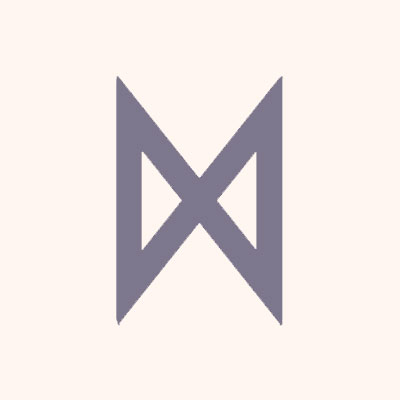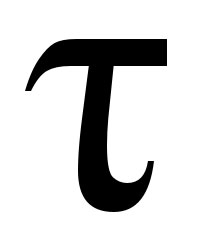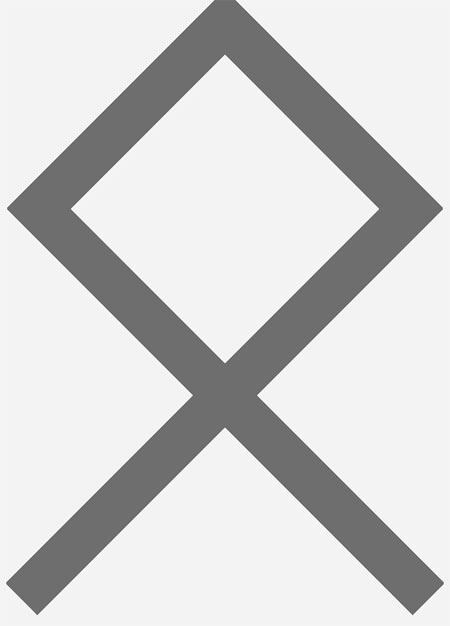Alphabets
The word alphabet as we know it comes from the first two letters of the Greek alphabet, alpha and beta. When the Greeks adapted the Phoenician alphabet to write Greek, they became the first civilization to create the very first true alphabet with a symbol assigned for each vowel and consonant. It is the oldest alphabetic script still in use today. It gave rise to the Latin, Gothic, Cyrillic, Coptic and Glagolitic alphabets. It is used in mathematics, physics, astrology etc. The best known and most widely used offshoots of the Greek alphabet are Latin (Roman) and Cyrillic which both have been adapted to write the numerous modern languages used all over the world today.
Other ancient alphabets like Anglo-Saxon, Scandinavian and Teutonic used runes. The Runic alphabet is traditionally known as futharka, after its first 6 letters (f-u-th-ar-k-a). Runes are characters not unlike Latin letters but with mostly straight lines and fewer curves as they were carved on surfaces using knives. Runic letters were used for just over a millennium and faded out just before the 16th century. It is far from dead however as it is still popular among New Agers who practice rune-reading to gain spiritual insight and see the future. Runes are reputed to be tools of divination.
Phi (The Golden Number)
The golden number or the divine ratio 1.618 is represented by the Greek letter Phi. Among other things, it is believed to be an acknowledgment for the 5th century Greek sculptor and mathematician Phidias who created sculptures for Olympus and the Parthenon.


Dagas
It is the rune character equivalent to the letter D; signifying day or dawn. It represents an awakening or a breakthrough. Rune readers would interpret it as the right time to make plans or embark on an enterprise.

Tau
The Greek letter Tau was derived from the Phoenician letter taw. In turn the Greek letter tau gave rise to the Roman T and Cyrillic Te. The ancients used this symbol to represent life or resurrection, opposite the letter theta, representing death.

Othala
This is the rune character equivalent to the letter O and stands for ancestral property or that which belongs to a person like a house or home. It stands for something of real value to a person, providing a safe haven.

Jera
Jera is the rune character that could either be a J or a Y. It represents a good harvest from earlier efforts, the result of past hard work, bringing hope, happiness and prosperity.

 Aramaic |
 Phoenician |
On this Page:
| Related Categories: |
Alphabet versus the Goddess
In the bestselling book, The Alphabet Versus The Goddess, Leonard Shlain proposes that the invention of writing, particularly alphabetic writing, rewired the brains of the people who learned how to communicate using this culture-changing tool. Great benefits to society followed. However, a precipitous decline in feminine values manifested by women's status, goddess veneration, nature, and representative art occurred in tandem.
alphabetvsgoddess.com/
Alphabet - wikipedia.org
An alphabet is a complete standardized set of letters — basic written symbols — each of which roughly represents a phoneme of a spoken language, either as it exists now or as it may have been in the past.
en.wikipedia.org/
John Higgins's silent alphabet
In 1968 an American linguist, answering the question "How do you pronounce TESOL?" (the acronym of the Association of Teachers of English to Speakers of Other Languages) answered: "T as in castle, E as in give, S as in island, O as in people, and L as in calm." In fact you can, with some use of proper names and loan words, create a complete silent alphabet for English.
myweb.tiscali.co.uk/
Alphabets - omniglot.com
Writing systems: abjads, alphabets, syllabic alphabets, syllabaries, complex scripts undeciphered scripts, alternative scripts, your con-scripts, A-Z index. Alphabets: Armenian, Avestan, Bassa (Vah), Beitha Kukju, Coptic, Cyrillic, Elbasan, Etruscan, Fraser, Georgian (Asomtavruli), Georgian (Nuskha-khucuri), Georgian (Mkhedruli), Glagolitic, Gothic, Greek, Hungarian Runes, International Phonetic Alphabet (IPA), and more.
omniglot.com/writing/alphabets.htm
Unifon alphabet
The Unifon alphabet, which was created by John Malone in 1959, is an alternative way of writing English based on the principle of one letter per phoneme.
omniglot.com/writing/unifon.htm
Phonetic Alphabets
These are not phonetic alphabets as in those used to guide pronounciation, rather they are a selection of alphabets used, particularly by radio operators, to spell out words. NATO & International Aviation, British Forces 1952, RAF 1942-43, Telecom B, British A or International, NY Police, French, German, Italian, Spanish.
morsecode.scphillips.com/alphabet.html
Alphabets for the Deaf/Blind
Moon Type
The Moon System of Embossed Reading. The majority of people who go blind in later life are unable to master the small dots of the braille system. For such people the Royal National Institute for the Blind provides an easier alternative system of embossed type.
bsblind.co.uk/full/moon/moontype.htm
Deafblind Manual Alphabet
A graphical image of the Deafblind Manual Alphabet.
deafblind.com/card.html
Braille - wikipedia.org
The Braille system is a method that is widely used by blind people to read and write, and was the first digital form of writing.
en.wikipedia.org/wiki/Braille
Braille script - omniglot.com
Braille is a writing system which enables blind and partially sighted people to read and write through touch. It was invented by Louis Braille (1809-1852), a French teacher of the blind.
omniglot.com/writing/braille.htm
Moon alphabet - omniglot.com
The Moon alphabet was invented by Dr. William Moon (1818-1894). Dr Moon lost his sight completely at the age of 21 after being partially sighted throughout his childhood.
omniglot.com/writing/moon.htm
Braille and ASL Specialty Fonts
Braille and Sign language fonts, True type, postscript for Windows and Macintosh.
tsbvi.edu/resources/
Animated Alphabets
Spin Animated Alphabet - IconBAZAAR
Permission is granted for limited personal use of up to twenty (20) images from ALL collections. ALL commercial or institutional use requires licensure.
iconbazaar.com/alphabets/animated/spin/
Animated Alphabets - virtuallandmedia.com
Sets of transparent animated GIFs.
virtuallandmedia.com/
Web Diner's Alphabets and Icons for Web Pages
A choice menu of downloadable alphabet graphics, including deco and script alphabets in a variety of colors, textures and styles. Don't miss the gold and two toned alphabets.
webdiner.com/alpha/alpha.htm
Children's Development of Writing
(PDF) - Young in Art
A developmental look at child art.
artjunction.org/young_in_art.pdf
Early Writing Development
Though most children in pre-kindergarten or kindergarten are approximately the same age, their writing levels usually have a wide range. Some children may be scribbling, but can tell you what their pictures are about.
lindaslearninglinks.com/earlywrtgdev.html
Stages of Childhood Writing
The earlier you encourage drawing/writing, the earlier you will see these stages.
literacy.kent.edu/Oasis/PACT/section1.html
Hebrew
Hebrew alphabet - wikipedia.org
The Hebrew alphabet, known variously by scholars as the Jewish script, square script, block script, or more historically, the Assyrian script, is used in the writing of the Hebrew language, as well as other Jewish languages, most notably Yiddish, Ladino, and Judeo-Arabic.
en.wikipedia.org/
Hebrew Alphabet
Vowels and Points, Styles of Writing, Transliteration, Numerical Values of Words.
jewishvirtuallibrary.org/
Origins of Alphabets
Invention of the Alphabet
Proto-Canaanite, also known as Proto-Sinaitic, was the first consonantal alphabet. Even a quick and cursory glance at its inventory of signs makes it very apparent of this script's Egyptian origin.
ixoloxi.com/alphabet/index.html
History, Development and Evolution of the World's Writing Systems
Writing came about much later than spoken language. It is not possible to determine which Language Family a language belongs to by looking at the writing system. Writing systems can be deployed for political or religious reasons as well as linguistic ones.
krysstal.com/writing.html
Proto-Hebrew alphabet
The Proto-Hebrew or Early Aramaic alphabet was developed sometime during the late 10th or early 9th century BC and replaced Assyrian cuneiform as the main writing system of the Assyrian empire.
omniglot.com/writing/aramaic.htm
Phoenician Alphabet
The Phoenician alphabetic script of 22 letters was used at Byblos as early as the 15th century B.C.
phoenicia.org/alphabet.html
Evolution of Alphabets
This page is part of the course material for "History of the Alphabets" taught by Prof. Robert Fradkin at University of Maryland. Animations showing the evolution of: Cuneiform character set, Phoenician character set, Greek character set, Arabic Character set, Square Aramaic/Hebrew character set, Modern Cyrillic character set, Latin character set.
terpconnect.umd.edu/
Origin of the Alphabet
The original alphabet was developed by a Semitic people living in or near Egypt. They based it on the idea developed by the Egyptians, but used their own specific symbols.
webspace.ship.edu/cgboer/alphabet.html
Phonetic Symbols
Resources For Studying Spoken English
IPA Phones and Phonemes of English, Variation in the sounds of English, Speech Waveform Analysis, Text to Speech (TTS) Synthesizers, Speech Recognition, Archives and Comprehensive Lists.
faculty.washington.edu/
Phonetic Picture - Writing
A phonetic picture-writing is a picture writing, which also can be read phonetically. For its ideograms are composed of specially designed letters, so that a thing or idea (e.g. "face") is shown. When reading these ideograms phonetically, the result is an artificial language with clear phonetics.
ieao.de/
International Phonetic Alphabet
International Phonetic Association (IPA), Phonetics, Reproduction of The International Phonetic Alphabet (Revised to 1993, Updated 1996).
langsci.ucl.ac.uk/ipa/
Sound Symbolism
Study of the apparent appropriateness of the sound-structures of many individual words for their meanings.
percepp.com/soundsmb.htm
Introduction
About
Contact
Symbols in The News
Interpret this Symbol
AAC
African
AI
Alchemy
Alphabets
Ancient
Animal Symbolism
Architecture
Art
Articles
Astrology
Baha'i
Blissymbolics
Blueprint Symbols
Buddhist
Celtic Symbols
Cemetery
Chinese Symbols
Christian
Circle
City
Codes
Color
Conlangs
Crop Circles
Danger
Da Vinci Code
Designing Logos
Dictionaries
Dreams
Education
Egyptian Symbols
Electrical
Emoticons
Find Images
Fonts
Food
Fraternity
Hamsa
Healing
Heraldry
Hermetic
Highway Signs
Hindu
History
Hobo
Holiday
Icons
iConji
Islamic
Jain Symbols
Japanese, Kanji
Jewish
Justice
Law
Literary Symbolism
Mandalas
Map
Masonic
Math, Number
Meaning of Names
Medical
Middle East
Military
Miscellaneous
Money
Music
Mythology
Native American
Playing Cards
Power
Psychology
QiQiiKhu
Reiki
Religious
Runes, Norse
Sacred Geometry
Scientific
Science Fiction
Sorority
Sports
Symbols in the News
Tattoos
ThirteenSymbols
Tree of Life
Ursprache
Videos
Visual Languages
Weather
Web Codes
Wicca
Words
Writing Systems
Braille
Coinherence
Coptic
Cuneiform
Easter Island
Etruscan
Happy Human
Hebrew
Kokopelli
Linear B
Lotus
Love Symbols
Mandorla
Moon Alphabet
Nine Pointed Star
Om
Oz
Phonetic
Scarab Beetle
Silent
Theosophy
Unifon
About
Contact
Symbols in The News
Interpret this Symbol
AAC
African
AI
Alchemy
Alphabets
Ancient
Animal Symbolism
Architecture
Art
Articles
Astrology
Baha'i
Blissymbolics
Blueprint Symbols
Buddhist
Celtic Symbols
Cemetery
Chinese Symbols
Christian
Circle
City
Codes
Color
Conlangs
Crop Circles
Danger
Da Vinci Code
Designing Logos
Dictionaries
Dreams
Education
Egyptian Symbols
Electrical
Emoticons
Find Images
Fonts
Food
Fraternity
Hamsa
Healing
Heraldry
Hermetic
Highway Signs
Hindu
History
Hobo
Holiday
Icons
iConji
Islamic
Jain Symbols
Japanese, Kanji
Jewish
Justice
Law
Literary Symbolism
Mandalas
Map
Masonic
Math, Number
Meaning of Names
Medical
Middle East
Military
Miscellaneous
Money
Music
Mythology
Native American
Playing Cards
Power
Psychology
QiQiiKhu
Reiki
Religious
Runes, Norse
Sacred Geometry
Scientific
Science Fiction
Sorority
Sports
Symbols in the News
Tattoos
ThirteenSymbols
Tree of Life
Ursprache
Videos
Visual Languages
Weather
Web Codes
Wicca
Words
Writing Systems
Braille
Coinherence
Coptic
Cuneiform
Easter Island
Etruscan
Happy Human
Hebrew
Kokopelli
Linear B
Lotus
Love Symbols
Mandorla
Moon Alphabet
Nine Pointed Star
Om
Oz
Phonetic
Scarab Beetle
Silent
Theosophy
Unifon
